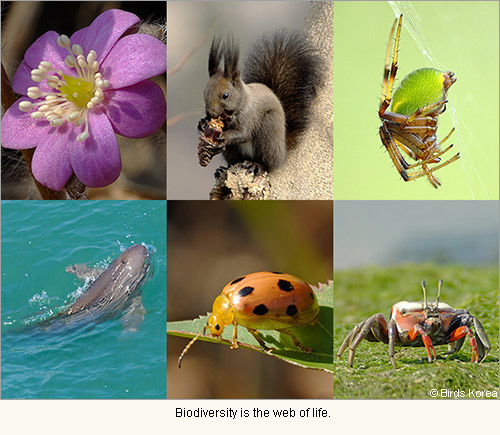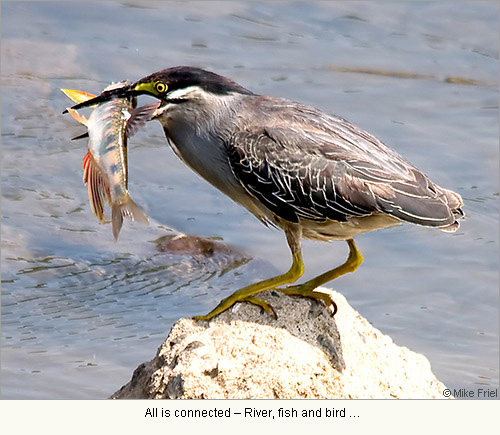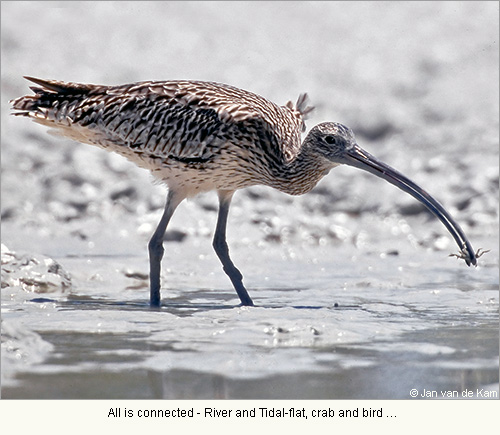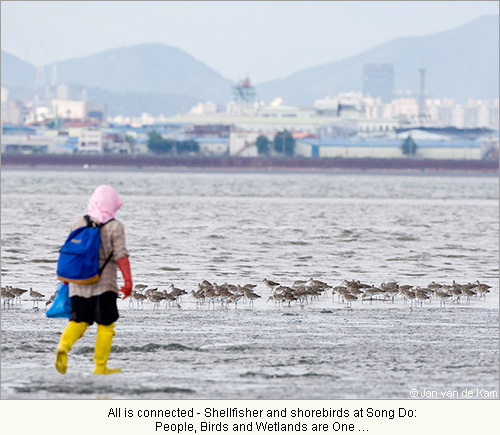This Update covers April 1st to July 10th 2010. It is in three parts:
The Proposed “Act on Preservation and Use of Biodiversity”:
A New Law and a New Way Forward?
2010, the United Nations-designated International Year of Biodiversity, was to be the year by which the rate of global biodiversity loss was to be reduced. This target has not been met.
In the words of the United Nations Secretary-General Ban Ki-Moon, “In 2002, the world's leaders agreed to achieve a significant reduction in the rate of biodiversity loss by 2010. Having reviewed all available evidence, including national reports submitted by Parties… the target has not been met. Moreover…the principal pressures leading to biodiversity loss are not just constant but are, in some cases, intensifying. The consequences of this collective failure, if it is not quickly corrected, will be severe for us all.” (Foreword, Global Biodiversity Outlook 3).
The world’s nations are failing to conserve biodiversity. And there is an increasingly urgent need to challenge “the principal pressures leading to biodiversity loss” in order to head off “severe” consequences.
Apparently in response to this growing biodiversity crisis, a new “Act on Preservation and Use of Biodiversity” is being drafted by the Ministry of Environment. (see: "Draft bill of Act on Preservation and Use of Biodiversity").
This new legislation is needed to help the nation correct some of the “failure” and to build on some of the positive steps that have been taken over the past few decades.
Positive steps in the Republic of Korea have included, for example, the designation of some species as National Natural Monuments and of protected areas, with “about 2.8% of the national territory, or 2,801.1 km2…designated as protected areas after the CBD COP-7 in 2004” (Fourth National Report to CBD). They have included the signing-on to the Ramsar Convention, to the Convention on Biological Diversity (CBD) and to bilateral Agreements like the Republic of Korea-Australia Migratory Bird Agreement. They have included the development of UNDP-GEF supported initiatives on Wetland Biodiversity and on Reducing Environmental Stress in the Yellow Sea Large Marine Ecosystem.
And probably the most important step forward of all has been the greatly increased public understanding of the need for conservation, achieved through a combination of the above, and by the tireless work of NGOs, educators and responsible media and decision-makers.
While it might be easy to agree on these successes, identifying the “failure” in present policy and legislation is, it seems, rather more controversial.
Globally “The five principal pressures directly driving biodiversity loss” are “habitat change, overexploitation, pollution, invasive alien species and climate change” (Executive Summary, Global Biodiversity Outlook 3).
Within the Republic of Korea, we believe that “habitat change” (habitat loss and degradation) is the most immediate and widespread of these pressures. And the root causes of habitat change are woven into the fabric of the present development model.

Habitat for Biodiversity
For example, despite the growing public interest in birds and the natural environment and the increasing number of Protected Areas, there are still no bird reserves or nature reserves in the Republic of Korea. There is, indeed, no area that Birds Korea is aware of that is being managed primarily and permanently for biodiversity. Almost all biodiversity-rich areas, whatever their status on paper, still seem to be vulnerable to development-driven policies, be it through inclusion in special development zones for industry or new housing, or for tourism infrastructure.
Stretches of natural coastline continue to be concreted or reclaimed, in contradiction of the formal government commitment made in 2008 that “intertidal mudflats should be preserved and that no large-scale reclamation projects are now being approved in the Republic of Korea” (Ramsar Resolution X.22). Rivers continue to be dammed and dredged on a huge scale, most recently as part of the Four Rivers Project. Forests continue to be cut, with almost 200,000 ha of forest area lost nationwide between 1978 and 2007 (Fourth National Report to CBD, p. 8). And even large areas of rice-field continue to be built on, with 18,215 ha and 22,680 ha of agricultural land in 2008 and 2009 respectively converted “into roads, rail roads and factories” (Yeonhap News, June 29th, 2010).
The huge Saemangeum reclamation is one of the most striking examples of the failure of existing policy and legislation to conserve the nation’s most bio-diverse ecosystems.
Based on government data (as well as our own), the Saemangeum estuarine system was the single most important known site for shorebirds in the nation and in the Yellow Sea. Because of its exceptional natural productivity, this vast estuarine system also supported the livelihoods of more than 20,000 local people. Despite existing obligations to CBD and Ramsar and years of court cases, Saemangeum’s national and global importance for biodiversity was not enough to prevent the construction of a 33-km seawall, which was closed in 2006 and now dams off the sea. What remains now at Saemangeum is a vast reclamation lake and desert-like tidal-flats. There is no “eco-city” there yet, and most remains unbuilt on. Much of the system therefore could be restored if tidal-flows were restored, even now. Yet there are still no plans to do so. The 40,000 ha of natural wetland now being destroyed at Saemangeum is equivalent in area to the forest nationwide being lost every four years, and to the area of agricultural land being lost nationwide every two years. The impacts on biodiversity are of course disproportionately even larger.
Even Ramsar sites are not safe from “habitat change” either. Since Ramsar Site designation, wetlands at Muan, Upo and Suncheon Bay for example all have increased infrastructure and new parkland and visitor centres, losing some of their “ecological character” in the process.
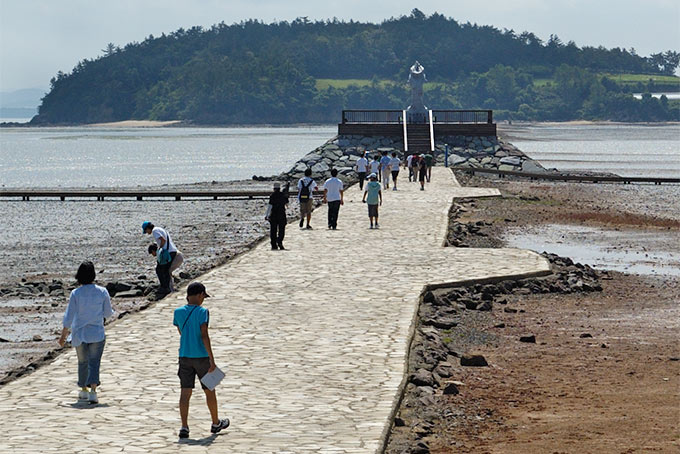
Photo © Birds Korea
According to Ramsar Article 2.2, “Wetlands should be selected (as Ramsar sites) on account of their international significance in terms of ecology, botany, zoology, limnology or hydrology”. The primary purpose of Ramsar sites is to conserve this international significance and the natural functions of wetlands. The primary purpose is not, for example, to maximise income from tourists at the cost of biodiversity loss. All the same, both Suncheon Bay and Upo (along with the DMZ) are now targeted for further development as “large-scale eco-tourism attractions” in recent proposals set out by the Ministry of Culture, Sports and Tourism (KBS, July 15).
While data on the impacts of biodiversity of all of this rapid habitat loss, degradation and disturbance remain poor or incomplete, many bird species do appear to be in decline.
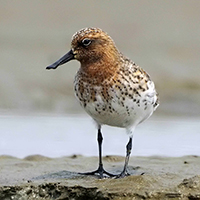
Photo © Richard Chandler

Photo © Tim Edelsten
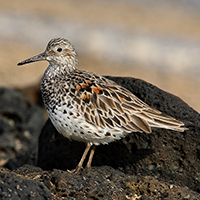
Photo © Robin Newlin

Photo © Jan v.d. Kam
In some cases, such as at Saemangeum, the impacts of habitat loss on species like the Great Knot Calidris tenuirostris, the now Critically Endangered Spoon-billed Sandpiper Eurynorhynchus pygmeus and on many other species of shorebird have been made clear by the Saemangeum Shorebird Monitoring Program. It is no coincidence, considering the large number of large-scale reclamation projects in recent years, that several other species ecologically dependent on inter-tidal wetlands, such as the globally Endangered Black-faced Spoonbill Platelea minor and the globally Vulnerable Chinese Egret Egretta eulophotes also have a poor national and global conservation status.
However, the range of threatened or declining bird species is not confined to one habitat type alone, of course. Many bird species of rivers, of freshwater marshes and rice-fields, of agricultural areas, of forests and of islands appear already to be in decline and are threatened by further large-scale habitat loss and degradation.
The declines in these species indicate negative changes to the same natural environment that we also depend on for life and livelihood. Drainage of wetlands, concreting of streams, cutting of forests, fragmentation of habitats through road construction, increasing disturbance, overuse of pesticides, and the resultant declines in natural vegetation and prey species due to all of these changes are combining to drive declines in avian and other biodiversity. This kind of habitat loss and degradation is not confined to the Republic of Korea, of course. It is taking place in some form or another throughout the region and throughout the world. And in many countries it is getting worse.
The Proposed Act on Preservation and Use of Biodiversity
Here in the Republic of Korea, newly proposed legislation aims ambitiously to “secure the health of the national ecosystem”. While stating clearly and unambiguously in the Rationale that “the nation’s biodiversity is continuously decreasing due to the pushing ahead of development-centred policies”, the proposed new legislation for now confines itself to:
Setting up and carrying out a National Strategy and Action Plan (which entails the further rationalisation of existing legislation);
Further reporting on the export of species;
Building a National Species’ Inventory;
Founding and running a Centre for Biodiversity;
Building and running a National Information Sharing System on Biodiversity;
Improving management of Alien Species; and
Supporting joint research and training
While applauding the positive elements that have already been included, Birds Korea believes that if the proposed new legislation is to be truly effective it needs to be even wider in scope. It needs to find ways to address all of the “five principal pressures”. Most especially it needs to reduce the pressure of “habitat change”. This is clearly in the national and the global interest.
For reasons outlined above and in our Letter to the Ministry of Environment (sent on July 20th, 2010), we believe that new legislation needs for example:
To help close the gap between international obligations held under e.g. the Ramsar Convention and CBD, and existing local / national policies and development projects;
To incorporate more fully Biodiversity Conservation into wider policy-making bodies/ decisions, and all ministerial briefs;
To strengthen aspects of Biodiversity Conservation in Protected Areas designation and management (with greater restriction of construction and disturbance in already specially-designated areas, including Ramsar sites);
To strengthen the Environmental Impact Assessment (EIA) by including mandatory use of bio-indicators in assessing potential impacts to sites’/national biodiversity, and by making the process considerably more open and transparent;
To include within the EIA or related legally-binding processes
Recognition of the economic costs and benefits to biodiversity of given development projects, and
Identification of those responsible for any likely decline in biodiversity.
Reduce perverse incentives through an increase in accountability, and through the establishment of a legally-binding mechanism for taxing or fining those responsible for causing biodiversity declines and loss through specific development projects;
Support local and specialised stakeholders’ involvement in EIA and in monitoring and assessing subsequent changes to biodiversity at sites affected by specific development projects through the amendment of existing EIA and related legislation.
Such changes appear to be in line, more than less, with the Articles of CBD and with the aims of the Strategy section of Global Biodiversity Outlook 3.
And changes such as these are needed much sooner than later. According to Achim Steiner of the UNEP, globally “For the past several decades, substantial net gains in economic development have come at the cost of biodiversity and the degradation of ecosystems. More than 60 percent of ecosystem services have been degraded in the past 50 years”.
Perhaps unaware of the ongoing reclamation of Saemangeum and the Song Do tidal-flats, the ongoing degradation of many of the nation’s rivers, and the continuing decline in the nation’s biodiversity, Mr. Steiner in the same interview added that the Republic of Korea is, in his opinion, already “in a leading position when it comes to global environmental issues” (Korea Times interview, Seeds sown for global biodiversity panel).

While this opinion is premature and overly optimistic, effective legislation and a host of upcoming major meetings could indeed help put our nation on track towards global environmental leadership.
With CBD COP10 in October, the G20 Meeting to be held in Seoul in November and the 2012 IUCN World Congress to be held on Jeju, the nation has numerous opportunities to take a leadership role in environmental and biodiversity conservation in the same way that it already shows leadership in other areas.
To correct the nation’s “failure” and to demonstrate this leadership, the nation needs as an urgent priority to reopen fully the sluice-gates at Saemangeum, to cancel further reclamation at Song Do and other internationally important sites, to restrict development in Protected Areas and Ramsar sites, and to scale-back or cancel the Four Rivers Project.
Such welcome and positive decisions, fully in line with existing conservation obligations and the Millennium Development Goals, would signal that the Republic of Korea is ready and willing to give up on the construction-driven addiction of the past few decades, and to lead us all, honestly and confidently, towards a much more bio-diverse and equitable future. We are waiting…
Resources
- KBS. The government’s plan to promote the nation’s tourism and leisure industry (July 15th).
Accessed on July 15th 2010 at: http://world.kbs.co.kr/english/news/news_commentary_detail.htm?No=19291 - Korea Times. Seeds Sown for Global Biodiversity Panel by Bae Ji-sook.
Accessed online at: http://www.koreatimes.co.kr/www/news/nation/2010/06/113_67383.html - Ministry of Foreign Affairs and Trade and Ministry of Environment, Republic of Korea. (2009). Fourth National Report to the Convention on Biological Diversity. In English.
Accessed on July 5th at: http://www.cbd.int/doc/world/kr/kr-nr-04-en.doc - Moores N., Rogers D., Kim R-H., Hassell C., Gosbell K., Kim S-A & Park M-N. (2008). The 2006-2008 Saemangeum Shorebird Monitoring Program Report. Birds Korea publication, Busan.
Online at: http://www.birdskorea.org/Habitats/Wetlands/Saemangeum/BK-HA-SSMP-report-2008.shtml - Secretariat to the Convention on Biological Diversity. (2010). Global Biodiversity Outlook 3. In English.
Accessed on July 10th at: http://gbo3.cbd.int/home.aspx
Highlights during the past few months include research work for the Blueprint; the opening of the Birds Korea Gallery; and the construction of a birdwatching hide by Mokpo City overlooking part of the Mokpo Namhang Urban Wetland.
Research
Work on “The Birds Korea Blueprint for the Conservation of the Avian Biodiversity of the West Sea” (“The Blueprint”) and on related scientific papers has continued, supported by a fieldwork scholarship from the “great University of Newcastle” (Australia) and a 6000 UK Pound Rufford Small Grant.
The Blueprint is bringing together best knowledge on key species and several key sites along the west coast of the Republic Korea, divided into the three main habitats of inter-tidal area, islands and open sea areas. Work on The Blueprint during April-June has included near-daily counts of migrants on Socheong Island through April and May, in order to develop an estimate of how many birds used the island during northward migration; observations of migrant arrival dates and counts on Eocheong and Gageo Islands; seabird transects; mapping of inter-tidal areas; and survey of the globally Vulnerable Styan’s Grasshopper Warbler Locustella pleskei, in order to understand more about this poorly-known species’ distribution, habitat needs and average territory size.
We will be posting much more on our websites about The Blueprint in the coming weeks and months. As planned, the first edition of The Blueprint will be published online and in hard copy in October in the run up to the Convention on Biological Diversity COP10 (Nagoya, Japan).
Planning and Design
After submitting our draft basic design for the Mokpo Namhang Urban Wetland in December 2009, we have been greatly encouraged by recent events at the site. Infilling of the wetland, for now at least, appears to have been suspended. Moreover, Mokpo City has taken the very welcome step of building the city’s first birdwatching hide there, overlooking the small estuary and one of the reclamation lagoons.

While it is still early days in Mokpo, we believe that the past few months have provided yet more evidence that our conservation approach can and does work.
Awareness-raising and Education
As part of our celebration of the International Year of Biodiversity, we are delighted this summer to open the Birds Korea Gallery on both our Korean-language and our English-language websites. If you have not done so yet, please take time to pay the Gallery a visit! The Birds Korea Gallery already contains over 2,200 images of 450 bird species photographed here in the Republic of Korea. In line with our Conservation Mission and ethics, all of the images are of wild birds; none of the images are of birds at the nest; none of the images use flash; and none, apart from a very few images of injured birds taken into care, are of birds showing obvious signs of stress. The success of this project is due in large part to Mr. Andreas Kim, Birds Korea’s outstanding web-spinner, who has built what one overseas visitor recently described as already “the best online resource for East Asian birds” anywhere. We hope that you agree!
We will be adding more images to the Gallery in the coming weeks and months, along with selected sound files of some of Korea’s wonderful birdlife. If you would like to contribute bird images for use in the Gallery, please send to gallery@birdskorea.org including your name, the date, and the location. Thank you!
To increase our effectiveness, we need your help! You do not need to be an expert. Only, you do need to be of good mind, and willing to share in our aims. For The Blueprint and for attendance at the CBD COP in Japan, we need your help with information-gathering, fact-checking or translation (Korean into English and English into Korean, and also Japanese into Korean or English!); for shorebird research in September, we need counters and “scribes”; and with everything we do, we need more members, and funding support!
Please join us in making a difference!
The following are exceptional observations made by Birds Koreans and from a collation of records by other observers posted on other leading birding websites, mostly especially the websites of the National Parks Migratory Bird Research Centre (NPMBRC), KWBS and BirdDB. Nomenclature, order and status codes follow The Birds Korea Checklist (2009).
Short-tailed Shearwater Puffinus tenuirostris P5
Exceptional numbers for Korean waters were reported during the period. First of the year was one seen between Incheon Port and Socheong Island by Nial Moores on May 15th followed by one seen near Manje Island in the far southwest (Jeollanam Province) on May 20th by Tim Edelsten. From May 21st, a new national high count of 500 (or more) was found by a researcher from the National Institute for Biological Resources off Mara Island (Jeju), and photographed by Kim Eun-Mi and other members of the Birds in Jeju club. On June 10th, three were seen in the East Sea off Ulsan by Shim Kyu-Sik, while on June 29th 65 were seen from the ferry between Nokdo and Weiyeon Island (Chungcheongnam Province) with a further 110 seen from Weiyeon Island itself (Nial Moores).
Black-faced Spoonbill Platalea minor EN S4, W5
At the highly-threatened Song Do site in Incheon, the mainland colony is breeding for the second consecutive year. On June 10th, 48 adult or fully-grown individuals and at least 14 nests, each containing apparently one or two unfledged chicks, were counted by Tim Edelsten. The tidal-flats where these birds feed is being reclaimed, with the outer seawall now half complete.
Japanese Night Heron Gorsachius goisagi EN.V1 (So)
On April 12th one was photographed on Jeju Island by Kim Young-Ho. In early May, one was photographed in Busan and posted to http://birddb.com (details withheld), with another photographed by Nial Moores and multiple other observers on Socheong Island between May 18th and at least June 1st. On May 29th, one was also photographed on Mara Island (Jeju), and posted to http://birdsinjeju.com.
Little Whimbrel Numenius minutus P5
Notable counts were of eleven on Socheong Island on April 20th (Nial Moores), and at least 40 (in three separate flocks) on Jeju Island on May 1st, seen by Matthew Poll & Kim Young-Ho, representing the highest national day count of this species known to Birds Korea.
Long-tailed Jaeger Stercorarius longicaudus V2
One was seen between Heuksan and Gageo Islands (Jeollanam Province) on April 17th by Robin Newlin. There are still fewer than five sight records from Korean waters. Lacking adequate documentation, this species remains in Category 3 of The Birds Korea Checklist.
Greater Coucal Centropus sinensis Category 4
A presumed Greater Coucal was seen by Andreas Petersen on Eocheong Island (Jeollabuk Province) on May 17th.
Lesser Coucal Centropus bengalensis V2
One photographed on Jeju Island by Kim Ho-Chon on June 6th becomes Korea's third record.
Asian Koel Eudynamys scolopaceus V2
One was heard on Socheong Island by Nial Moores shortly after dawn on May 28th, becoming the third national record (after one heard on Socheong in April 2009 by Kim Dong-Won).
Large Hawk-Cuckoo Heirococcyx sparverioides V2
One was heard singing in the east of Socheong Island on May 19th by Nial Moores, with another, (presumed newly arrived) seen well in the south west of the island on May 27th (Nial Moores and Tim Edelsten). These are approximately the seventh or eighth records for the ROK, since the first in 2007.
Black-winged Cuckooshrike Coracina melaschistos V2
One photographed on Eocheong Island on May 15th by Andreas Petersen and Torbjørn Eriksen was followed by another photographed on Socheong Island by Nial Moores on May 31st.
Ashy Drongo Dicrurus leucophaeus V1
One photographed on Mungap Island, Incheon, by Joh Song-Sik on May 5th is believed to be approximately the 9th record for the ROK and 10th for the Korean Peninsula.
Asian Paradise Flycatcher Terpsiphone paradisi V2
One was seen on Socheong Island by Nial Moores on May 18th.
House Crow Corvus splendens
One was found and photographed on Mungap Island, Incheon, on May 7th by members of Birds in Incheon and KWBS. It was still present on June 25th (Nial Moores and Tim Edelsten). Considering the location, ship-assistance seems probable. The species will be added to Category One of The Birds Korea Checklist during the next update.
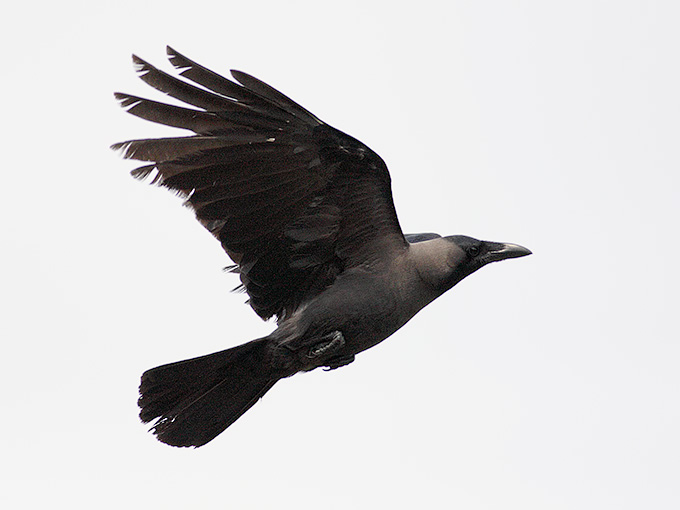
Asian Short-toed Lark Calandrella cheleensis V2
Following on from the very small autumn influx, one was photographed on Weiyeon Island on April 2nd and 3rd (Park Heung-Sik, NPMBC). On Socheong Island, one was photographed and sound-recorded on April 3rd & 4th by Nial Moores.
Eurasian Crag Martin Ptyonoprogne rupestris V2
One seen on Dokjeok Island, Incheon, by Dominic Le Croisette and Heather Henrichs on May 21st is believed to be approximately the sixth national record.
Common House Martin Delichon urbicum lagopodum V1
A very scarce migrant, recorded annually since 2003. At least eight were seen on Socheong Island by Nial Moores and Tim Edelsten on May 25th. This is the highest day count of the species in the Republic of Korea known to Birds Korea

Tickell's Leaf Warbler Phylloscopus affinis V2
One was seen by Andreas Petersen and Torbjørn Eriksen on Eocheong Island on May 11th. This is approximately the sixth record for Korea
Claudia's Leaf Warbler Phylloscopus claudiae V2
The 2009 record of Claudia’s Leaf Warbler is now under review, following a comparison of a recording of its song with online recordings of Hartert’s Leaf Warbler Phylloscopus goodsoni.
On April 25th 2010, a Claudia’s or Hartert’s Leaf Warbler was heard by Nial Moores on Socheong Island, giving song-introduction phrase very similar to the 2009 bird.
Manchurian Reed Warbler Acrocephalus tangorum VU. V2
One seen on Socheong Island by Nial Moores on May 18th is only about the fourth national record, with the first in 2000.
Baikal Bush Warbler Bradypterus davidi V2
All records from Socheong Island. On May 29th, one was seen and heard singing by Tim Edelsten, with one also sound-recorded and another flushed by Nial Moores at two other locations on the island. On May 30th, another was heard by Tim Edelsten.
Orange-headed Thrush Zoothera citrina V2
One probable on Socheong Island on May 27th (Nial Moores) was followed by one photographed at a different location on the same island by Nial Moores and Tim Edelsten on May 31st. There is only one previous national record, from Hong Island, Jeollanam Province in May 2004.

Black Redstart Phoenicurus ochruros V1
There were ten or more records of this species during April and May, with five or six on Socheong Island on various dates between April 4th and May 2nd (all records Nial Moores), one on Gageo Island (first seen on April 24th by Robin Newlin and seen again on April 27th & 29th by Tim Edelsten), and at least four other individuals, photographed on a further three different western islands during April and posted to Birddb.com (details withheld).
Grey Bush Chat Saxicola ferreus V2
One male, photographed on Heuksan Island (Jeollanam Province) by Park Chang-Wook (NPMBC) on March 26th is the tenth national record.
Isabelline Wheater Oenanthe isabellina V2
First recorded in 2003. One apparently photographed on a western island in late April and posted to Birddb.com (details withheld) becomes only the fourth record for the Republic of Korea.
Pied Wheatear Oenanthe pleschanka V1
One photographed on a southern island in early April was still present a week later (both records via Birddbb.com: details withheld). This was followed by one photographed on Socheong Island on May 7th by Nial Moores. There are about ten previous records known to Birds Korea.
Chinese Flycatcher Ficedula elisae V2
A flycatcher photographed on Gageo Island by Tim Edelsten on April 27th was initially considered to be of this taxon, though further review of the images is now being undertaken. A probable female was then seen on Socheong Island by Nial Moores on May 18th.
House Sparrow Passer domesticus V2
One adult male photographed on Weiyeon Island by Lee Woo-Man on May 20th, is believed to be probably only the third record for the Korean Peninsula, after two on Gageo Island in 2002 (under review) and one on Heuksan Island in May 2006.
http://kwbs.or.kr/bbs/board.php?bo_table=search&wr_id=5888
Godlewskii's Bunting Emberiza godlewskii
One photographed and sound-recorded on Socheong Island by Nial Moores on April 15th is the first record for the Republic of Korea and the Korean peninsula. The species will be added to Category One of The Birds Korea Checklist during the next Checklist Update.

Red-headed Bunting Emberiza bruniceps V2
One was claimed by Andreas Petersen and Torbjørn Eriksen on Eocheong Island on May 12th. Details have been requested.
Golden-crowned Sparrow Zonotrichia atricapilla
One found and photographed by members of KWBS on Weiyeon Island on April 10th, and still present a week or more later, is the first record for the Republic of Korea and the Korean peninsula. The species will be added to Category One of the Birds Korea Checklist during the next Checklist Update.

Finally, a gentle reminder to all of our members (past and present) living in Korea. Birds Korea depends entirely on the support of our members and volunteers. Donations and domestic membership fees are vital to us! Please renew your membership and help us to help the birds!
This update was prepared through the joint efforts of Nial Moores, Kim Sona, Andreas Kim, Park Meena, and Tim Edelsten, with contributions by many members.
Birds Korea, July 15th, 2010.





